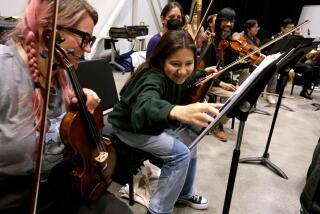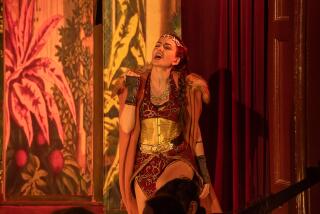Playing beyond the boundaries
- Share via
L’Orchestra di Piazza Vittorio sounds like the name of yet another ensemble dedicated to period music, or perhaps a Roman version of Andre Rieu’s colorful Johann Strauss Orchestra.
Neither comes close to the reality of this remarkable gathering of musicians. And the group’s performance Thursday night at the Egyptian Theatre, directly following a screening of “The Orchestra of Piazza Vittorio,” the award-winning documentary about the group’s creation, was a mesmerizing display of beyond-boundary music making.
“Beyond-boundary” because the orchestra consists of players from Tunisia, Brazil, Ecuador, Hungary, Cuba, Senegal, Italy and beyond. Artistic director and keyboardist Mario Tronco -- with the aid of the ensemble’s array of musically diverse personalities -- has assembled a musical collective that travels convincing communal pathways between disparate cultures.
Happily avoiding the too-prevalent world-music tendency to underscore ethnic sounds and melodies with faceless, studio-manufactured grooves, the orchestra instead freely mixed and matched real-world musical elements. The results were both unexpected and surprisingly effective: the atmospheric echoes of jazz that the trumpet of Cuba’s Omar Lopez Valle added beneath the oud and vocals of Tunisia’s Ziad Trabelsi and Houcine Ataa; surging rock rhythms and cool backup vocals behind Middle Eastern melodic phrases; and Latin percussion blending empathetically with African rhythms.
Virtually every individual who stepped into the spotlight had the musicality and the charisma to have a solo career. The most engaging was Ecuador’s Carlos Paz, singing the wordless “Tarareando” -- a wonderfully infectious little melody made even more entertaining by its use in the documentary as a running gag. Brazil’s Evandro Cesar Dos Reis brought a boy-band sweetness (with impeccable musicality) to his vocal and guitar on a lovely bolero-like tune, “Vagabundo Soy,” written by Lopez Valle.
Supporting everything, Hungarian cellist Eszter Nagypal, percussionists Awalys Ernesto “El Kiri” Lopez Maturell from Cuba, El Hadji “Pap” Yeri Samb from Senegal and bassist Pino Pecorelli from Italy played with eclectic musical authenticity.
The performance was made all the more entertaining by its presentation as a climax to the screening of the documentary. The Piazza Vittorio Emanuele II is a center for Rome’s immigrant population. And the documentary explores, in gripping, cinema verite fashion, the sometimes-Odyssean, sometimes-whimsical process in which Tronco scoured the area to gather the multinational, multi-ethnic players of L’Orchestra di Piazza Vittorio.
More to Read
The biggest entertainment stories
Get our big stories about Hollywood, film, television, music, arts, culture and more right in your inbox as soon as they publish.
You may occasionally receive promotional content from the Los Angeles Times.










